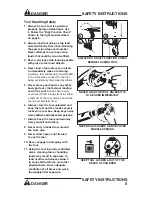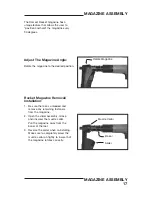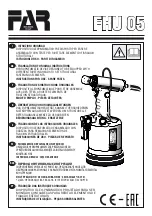
FASTENING APPLICATIONS
Your Ramset tool can be used for a wide
range of fastening needs in a variety of base
materials.Reading and follow these important
fastening guidelines will help you get the best
results from your tool, fasteners, and powder
loads, as well as help you perform these
fastening operations safely and effectively.
Powder actuated fastenings are permanent
fastening so attempting to remove a fastener
from concrete or steel may result in serious
injury.
Fastening to Concrete
When fastening into concrete, always maintain
a minimum spacing of 3” between fastenings
and 3” from any free edge. Concrete thickness
should be at least three times the intended
penetration depth into the concrete. The
primary exception to the 3” edge distance
can occur in a sill plate application where,
by necessity, the edge distance is reduced.
Driving fasteners too close to an edge or too
close to each other can cause the concrete
edge to fail or fasteners to fly free.
Fastening to Concrete Block or
to Masonry Walls
While this application is not recommended,
when used, it is necessary to take care to
observe a 3” edge distance to avoid cracking
the block and over penetration of the fastener
to avoid loss of holding value. Fastening
may be made into the horizontal joint but
not into the vertical joint.
Fastening to Steel
Your Ramset tool can be used for fastening
on the flat surfaces of structural steel. When
fastening into steel, always maintain a mini-
mum spacing of 1-1/2” between fastenings
and 1/2” from any edge.
FASTENING APPLICATIONS
FASTENING APPLICATIONS
8
3"
MIN.
3"
MIN.
3" MIN.
3" MIN.
1/2"
MIN.
1-1/2"
MIN.
SPACING WOOD TO CONCRETE
3"
MIN.
3"
MIN.
3" MIN.
3" MIN.
1/2"
MIN.
1-1/2"
MIN.
PENETRATION — THIN GAUGE
METAL TO CONCRETE
3"
MIN.
3"
MIN.
3" MIN.
3" MIN.
1/2"
MIN.
1-1/2"
MIN.
SPACING — FURRING
STRIP TO CONCRETE
3"
MIN.
3"
MIN.
3" MIN.
3" MIN.
1/2"
MIN.
1-1/2"
MIN.
SPACING — STEEL TO STEEL




































